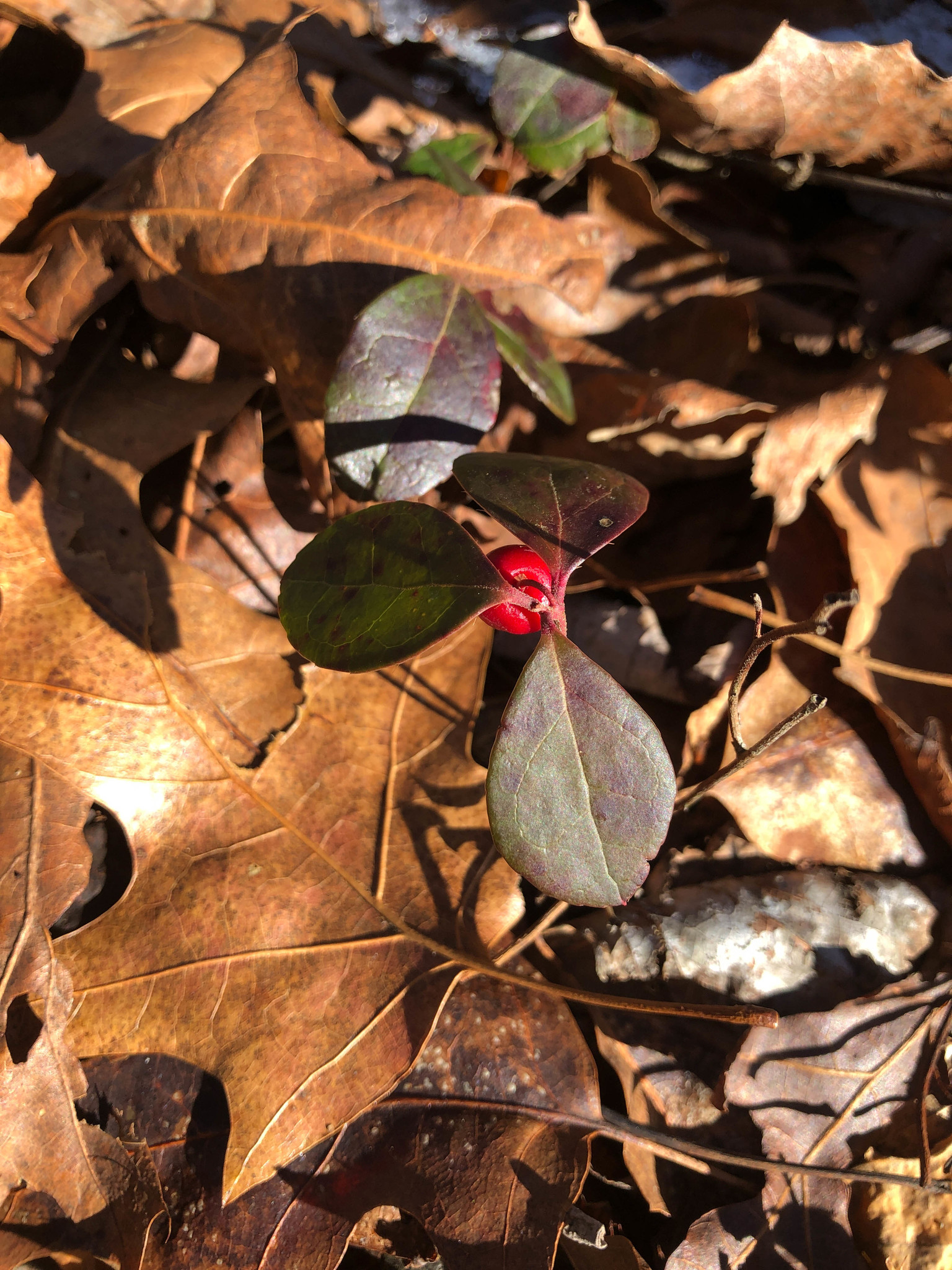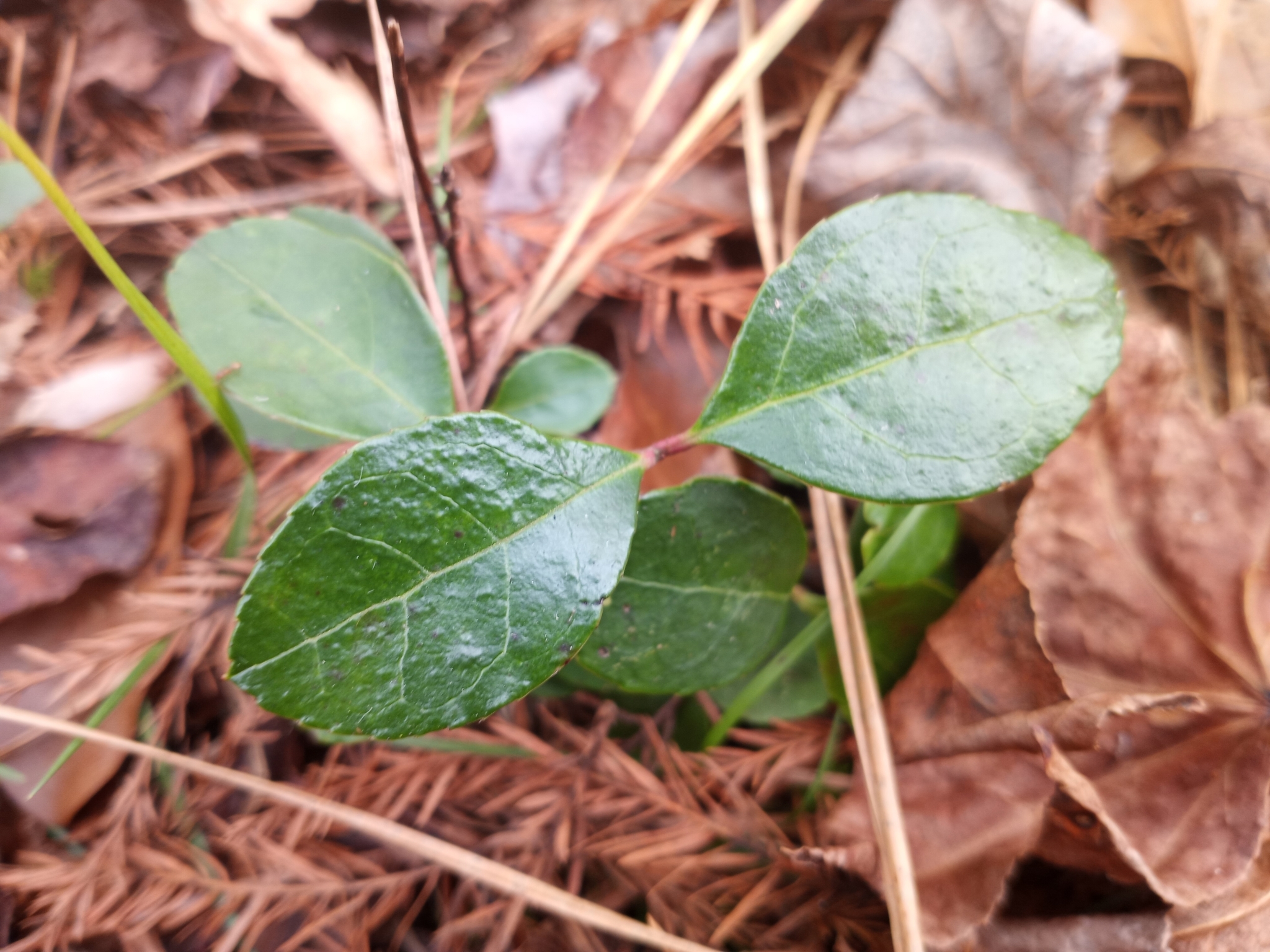Map Snapshot


















341 Records
Seasonality Snapshot
Source: Wikipedia
| Gaultheria procumbens | |
|---|---|

| |
| The ripe berries in October in Hammond, Indiana | |
| Scientific classification | |
| Kingdom: | Plantae |
| Clade: | Tracheophytes |
| Clade: | Angiosperms |
| Clade: | Eudicots |
| Clade: | Asterids |
| Order: | Ericales |
| Family: | Ericaceae |
| Genus: | Gaultheria |
| Species: | G. procumbens
|
| Binomial name | |
| Gaultheria procumbens | |
Gaultheria procumbens, also called the eastern teaberry, the checkerberry,[a] the boxberry, or the American wintergreen, is a species of Gaultheria native to northeastern North America from Newfoundland west to southeastern Manitoba, and south to Alabama.[1] It is a member of the Ericaceae (heath family).[2]
Growth and habitat
[edit]
G. procumbens is a small, low-growing shrub, typically reaching 10–15 cm (4–6 in) tall. The leaves are evergreen, elliptic to ovate, 2–5 cm (3⁄4–2 in) long and 1–2 cm (1⁄2–3⁄4 in) broad, with a distinct oil of wintergreen scent.
The flowers are pendulous, with a white, sometimes pink-tinged,[3] bell-shaped corolla with five teeth at the tip 8–10 mm (0.31–0.39 in) long, and above it a white calyx. They are borne in leaf axils, usually one to three per stem. The anthers are forked somewhat like a snake's tongue, with two awns at the tip.[4]
The fruit is red and 6–9 mm (0.24–0.35 in) across.[4] It is an epigynous berry, with the majority of the flesh of the fruit being composed of the fleshy calyx.
The plant is a calcifuge, favoring acidic soil, in pine or hardwood forests, although it generally produces fruit only in sunnier areas.[5] It often grows as part of the heath complex in an oak–heath forest.[6][7][8]
G. procumbens spreads by means of long rhizomes, which are within the top 2–3 cm (3⁄4–1+1⁄4 in) of soil. Because of the shallow nature of the rhizomes, it does not survive most forest fires, but a brief or mild fire may leave rhizomes intact, from which the plant can regrow even if the above-ground shrub was consumed.[5]
This plant has gained the Royal Horticultural Society's Award of Garden Merit.[9][10]
Edibility
[edit]The fruits of G. procumbens, considered its actual "teaberries", are edible, with a taste of mildly sweet wintergreen similar to the flavors of the Mentha varieties M. piperita (peppermint) and M. spicata (spearmint) even though G. procumbens is not a true mint. The leaves and branches make a fine herbal tea, through normal drying and infusion process. For the leaves to yield significant amounts of their essential oil, they need to be fermented for at least three days.[11] The berries and leaves contain methyl salicylate, a compound that is closely related to aspirin.[12]
Teaberry extract can be used to flavor tea, candy, medicine and chewing gum.[13] Teaberry is also a regional flavor of ice cream in Pennsylvania.[14][15][16] It likewise inspired the name of Clark's Teaberry chewing gum.
Wildlife value
[edit]Wintergreen is not taken in large quantities by any species of wildlife, but the regularity of its use enhances its importance. Its fruit persist through the winter, and it is one of the few sources of green leaves in winter. White-tailed deer browse wintergreen throughout its range, and in some localities it is an important winter food. Other animals that eat wintergreen are wild turkey, sharp-tailed grouse, northern bobwhite, ring-necked pheasant, black bear, white-footed mouse, and red fox. Wintergreen is a favorite food of the eastern chipmunk, and the leaves are a minor winter food of the gray squirrel in Virginia.[5]
Common names
[edit]Other common names for G. procumbens include American mountain tea, boxberry, Canada tea, canterberry, checkerberry, chickenberry, creeping wintergreen, deerberry, drunkards, gingerberry, greenberry, ground berry, ground tea, grouseberry, hillberry, mountain tea, one-berry, procalm, red pollom, spice berry, squaw vine, star berry, spiceberry, spicy wintergreen, spring wintergreen, teaberry, wax cluster, and youngsters.[9][17]
While this plant is sometimes mistakenly known as partridge berry,[18] that name more often refers to the ground cover Mitchella repens.
Traditional use
[edit]The plant has been used by various tribes of Native Americans for medicinal purposes. The Delaware, Mohicans, and several other tribes made a tea from wintergreen leaves to treat kidney disorders. The Great Lakes and Eastern Woodlands tribes used a wintergreen poultice as a topical treatment for arthritic pain.[19]
See also
[edit]- Clark's Teaberry
- Teaberry ice cream
- Wintergreens
- Gaultheria humifusa - alpine wintergreen
- Gaultheria ovatifolia - western teaberry or Oregon spicy wintergreen
Gallery
[edit]-
The forked anthers in a dissected flower
-
19th century illustration
-
Dense growth with berries and red-tinged new leaves
Notes
[edit]- ^ This name also sometimes refers to Mitchella repens (the partridge berry).
References
[edit]- ^ "Gaultheria procumbens". Germplasm Resources Information Network. Agricultural Research Service, United States Department of Agriculture. Retrieved 2017-12-16.
- ^ Dwelley, Marilyn J. (1977). Summer & Fall Wildflowers of New England. Down East Enterprise, Inc. p. 60. ISBN 978-0-89272-020-0. Retrieved 2008-08-10.
- ^ Chayka, Katy; Dziuk, Peter (2016). "Gaultheria procumbens (Wintergreen)". Minnesota Wildflowers.
- ^ a b Trock, Debra K. (2009). "Gaultheria procumbens". In Flora of North America Editorial Committee (ed.). Flora of North America North of Mexico (FNA). Vol. 8. New York and Oxford: Oxford University Press – via eFloras.org, Missouri Botanical Garden, St. Louis, MO & Harvard University Herbaria, Cambridge, MA.
- ^ a b c Coladonato, Milo (1994). "Gaultheria procumbens". Fire Effects Information System (FEIS). US Department of Agriculture (USDA), Forest Service (USFS), Rocky Mountain Research Station, Fire Sciences Laboratory.
- ^ "Oak / Heath Forests". The Natural Communities of Virginia: Classification of Ecological Community Groups (Version 2.3). Virginia Department of Conservation and Recreation. 2010. Archived from the original on 2009-01-15.
- ^ Fleming, G. P.; Patterson, K. D.; Taverna, K. (2017). "Oak / Heath Forests". The Natural Communities of Virginia: Classification of Ecological Groups and Community Types (Version 3.0). Richmond: Virginia Department of Conservation and Recreation, Division of Natural Heritage. Retrieved 2018-08-01.
- ^ Schafale, M. P.; Weakley, A. S. (1990). "Classification of the natural communities of North Carolina: third approximation". North Carolina Natural Heritage Program, North Carolina Division of Parks and Recreation.
- ^ a b "Gaultheria procumbens". RHS Gardening. Royal Horticultural Society. 2018.
- ^ "AGM Plants - Ornamental" (PDF). Royal Horticultural Society. July 2017. p. 39. Retrieved 28 July 2018.
- ^ Gibbons, Euell (1966). Stalking the Healthful Herbs. New York: David McKay. p. 92.
- ^ Elias, Thomas S.; Dykeman, Peter A. (2009) [1982]. Edible Wild Plants: A North American Field Guide to Over 200 Natural Foods. New York: Sterling. p. 150. ISBN 978-1-4027-6715-9. OCLC 244766414.
- ^ Niering, William A.; Olmstead, Nancy C. (1985) [1979]. The Audubon Society Field Guide to North American Wildflowers, Eastern Region. Knopf. p. 499. ISBN 0-394-50432-1.
- ^ Maslovara, Vedran (2022-03-23). "The Ice Cream Flavor You Can (Almost) Only Find In Pennsylvania". Mashed. Retrieved 2023-11-26.
- ^ Grossinger, Zoe (2019-07-10). "Why this bright pink ice cream is the most-searched flavor in PA". Billy Penn at WHYY. Retrieved 2023-11-26.
- ^ Bombay, Brandon (2023-07-07). "The Beloved Pennsylvania Ice Cream That Some Say Tastes Like Medicine". The Daily Meal. Retrieved 2023-11-26.
- ^ Lust, John (1974). The Herb Book. Bantam Books. p. 404. ISBN 978-0-553-26770-9. Retrieved 2008-08-10.
- ^ Hall, Joan Houston (2002). Dictionary of American Regional English. Harvard University Press. p. 47. ISBN 978-0-674-00884-7. Retrieved 2007-11-16.
- ^ Cichoke, Anthony J. (2001). "Secrets of Native American Herbal Remedies". Avery.
External links
[edit]- Blanchan, Neltje (2005). Wild Flowers Worth Knowing. Project Gutenberg Literary Archive Foundation.
- . Encyclopædia Britannica (11th ed.). 1911.



















